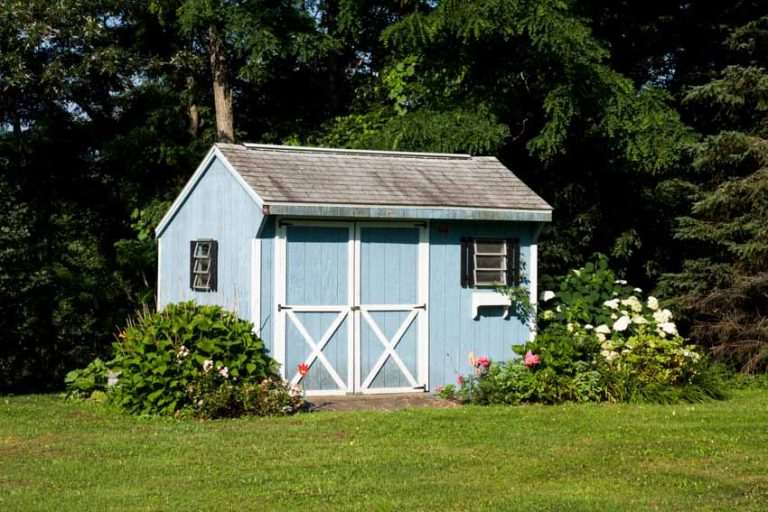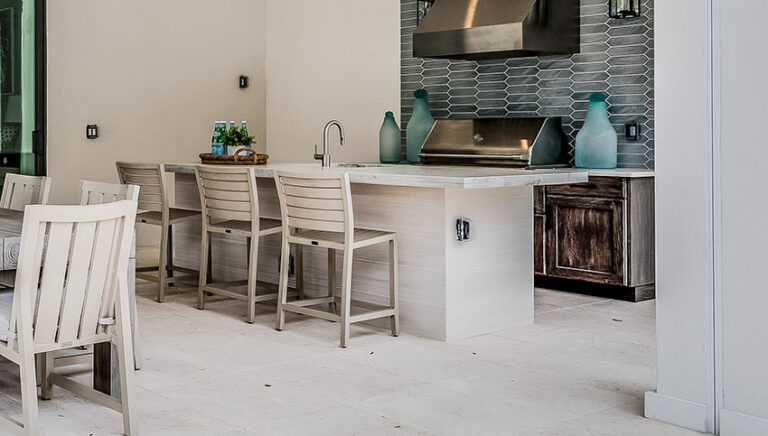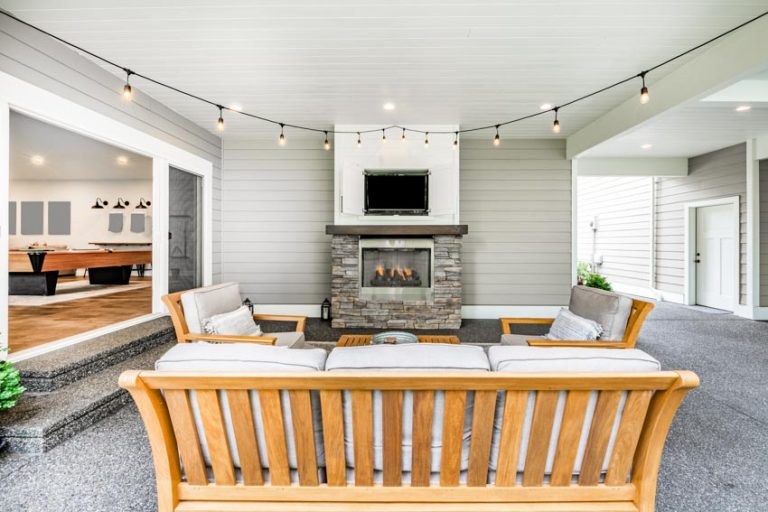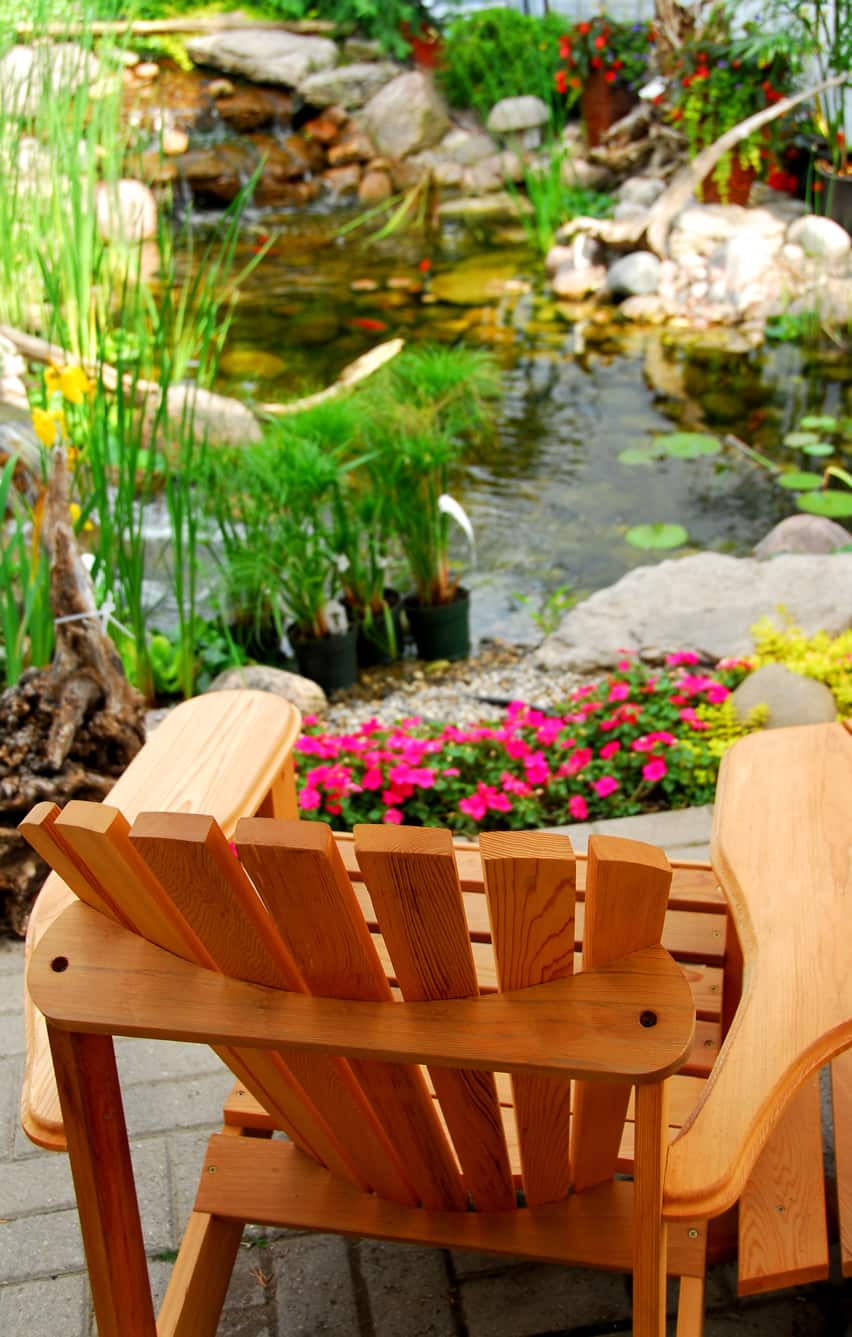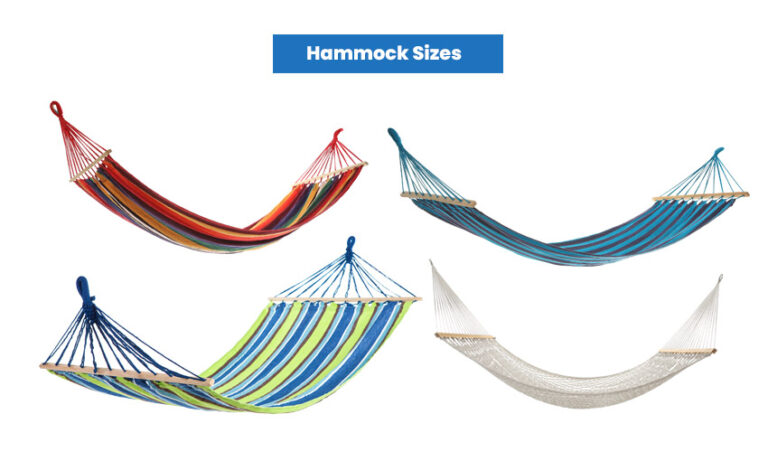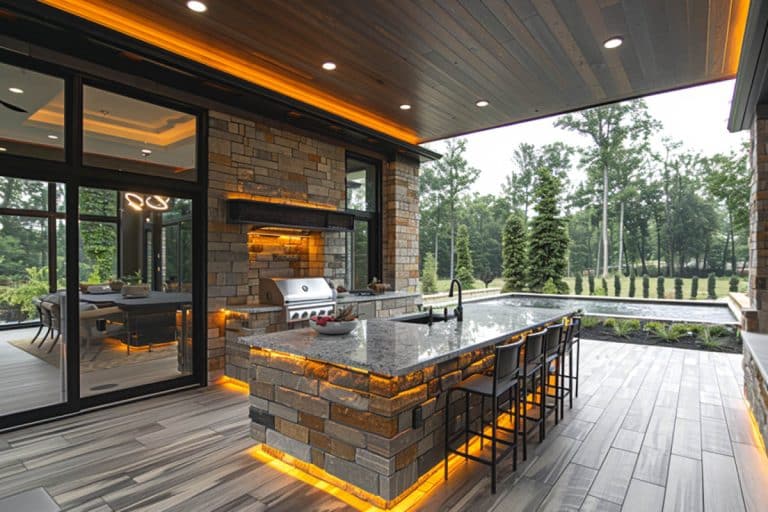Outdoor Shower Ideas (Picture Gallery)
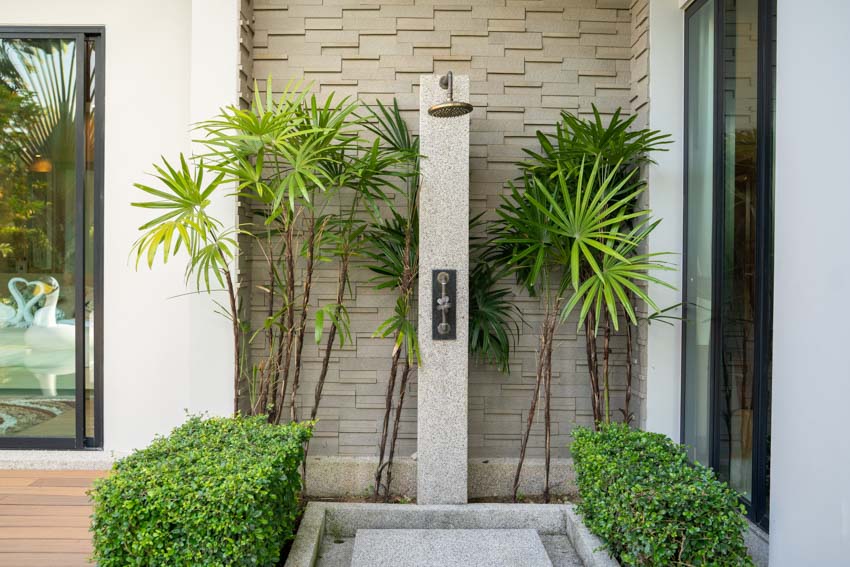
Showering feels like an intimate activity that you’d like to have as much privacy as possible. But if want the freeing feeling of being outside while enjoying how water trickles down your body, you can actually opt for an outdoor shower. Yes, a shower outside your own home! Enclosed or not, an outdoor shower may use a simple plumbing system consisting of valves, water pipes, and a shower head with the water source in the form of the home’s main water supply.
Pros and Cons of a Shower Outdoors
Here are some of the advantages and disadvantages you can face when using an outdoor shower.
| Benefits | Drawbacks |
| Adds value to the home | Possible lack of privacy |
| Helps keep the pool clean | Needs regular cleaning |
| Can cool you off in the summer | Not usable all year round |
| Excellent to clean off children and pets | Some may be expensive to buy and install |
Outdoor showers are guaranteed to add value to your home and can dramatically increase the home’s asking price, whatever the style it may have from minimalist to modern.
Types of Outdoor Showers
There are different types of outdoor showers you can choose from when planning for one in your own home. Would you want it wall-mounted and connected to the infrastructure of your home or do you prefer a freestanding one? You would need to answer these questions as you plan out your outdoor bathing space.

Plumbing can be made simple and tidy like this open-air bathing station, with a spray head at the top, a valve at the center of the wall, and a platform you can step on at the bottom. The greenery on both sides somehow adds a fresh look to it.
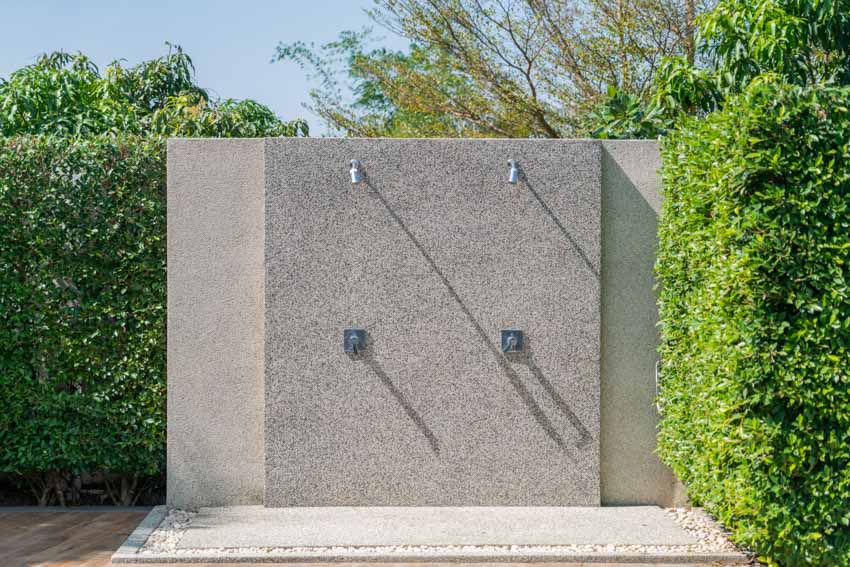
This outdoor bathing space features two shower heads and valves attached to concrete, allowing the use of two people simultaneously.
Minimalist in its style, this will seem like having two showers, which is beneficial if you have a big family. But of course, that’s if you can be comfortable showering with another person.

Attached to a gray concrete wall, this outdoor bathing space offers a luxurious view of the sea that you can enjoy. The gray concrete bath wall matches the gray floor tiles, giving it a unified look.
The drawback, though, is that privacy seems to be the last thing on mind when this outdoor bathing space was designed because of its large open space.
There is a variety of options to consider once you plan your outdoor bathing space. Check out these ideas if they can come in handy for you.
Shower Enclosures
Having an outdoor bathing space does not mean you have to give up your privacy entirely. You can create a sense of privacy by using a solid enclosure, whether it is a full one or just a part of it.
You can erect partitions just enough to cover up to your head or just around five feet just to cover your intimate parts. Position the partitions where you will be hidden in public eyes.
One good thing about enclosures is that you can get creative with the materials you use. From wood to stone, your enclosure could be styled in whatever way you can.
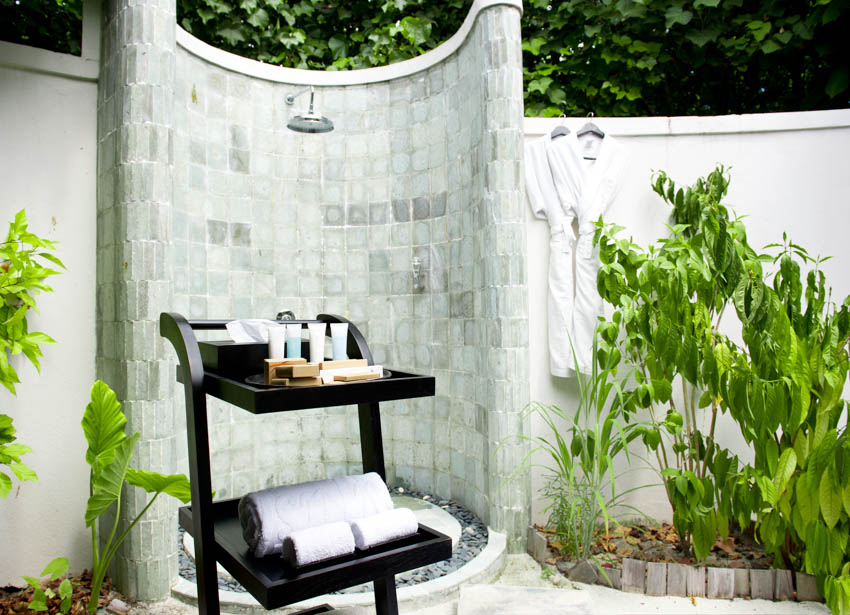
This outdoor bathing space features a solid round enclosure with a rain spray head installed at the top. The enclosure has this rustic old stone look balanced by the plants on its sides. It also features a black shelf in the open part of the enclosure holding your toiletries while you bathe.

Featuring a natural kind of enclosure, this outdoor bath area has a simple spray head hanging on top and a single line of water tube connecting it to the water source.
The enclosure is in the form of a reverse U-shape shrub that covers way above your head for your privacy. It also features a concrete platform to support your solid footing while showering.
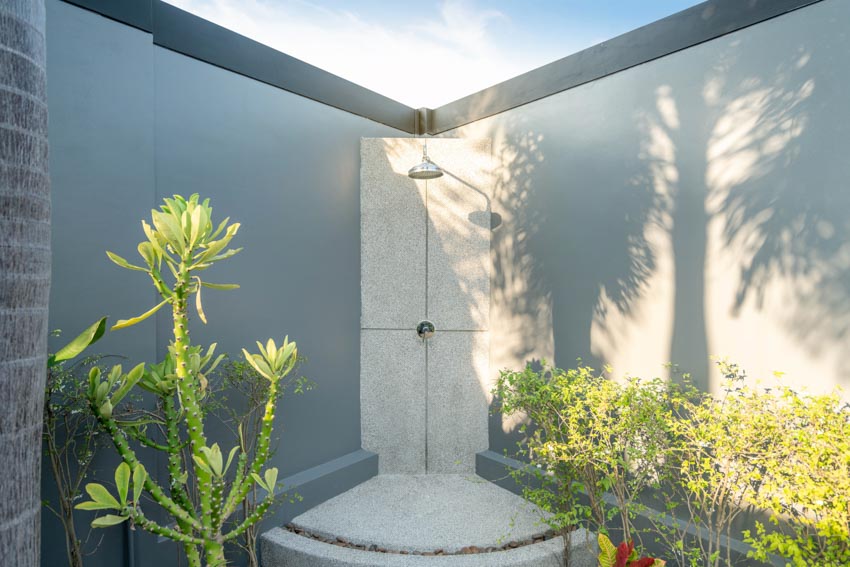
This outdoor shower with enclosure features a concrete platform you can step on to bathe. The spray head is attached to the wall that’s connected to the two connecting perpendicular high walls. The enclosure is made up of concrete walls and is accented with plants on the side to improve its aesthetic.
DIY Shower
If you want more flexibility in designing your outdoor bathing space, you can actually build it on your own. If you have the time, consider it a summer DIY project. And yes, it takes more than just hanging a garden hose on your garden wall!
Consider your budget, the materials you want to work with, and the design and style you want your outdoor bathing space to have. Whether it is free-standing or night, decide on these factors before you even start working on the outdoor bathing space.
This option is more affordable, especially since you won’t have to pay for labor in building the outdoor bathing space. You just need to consider a simple plumbing system, basic lumber, and corrugated tin if you go for the most affordable elements. An outdoor wash nook kit can help you if you don’t know where to start with this.
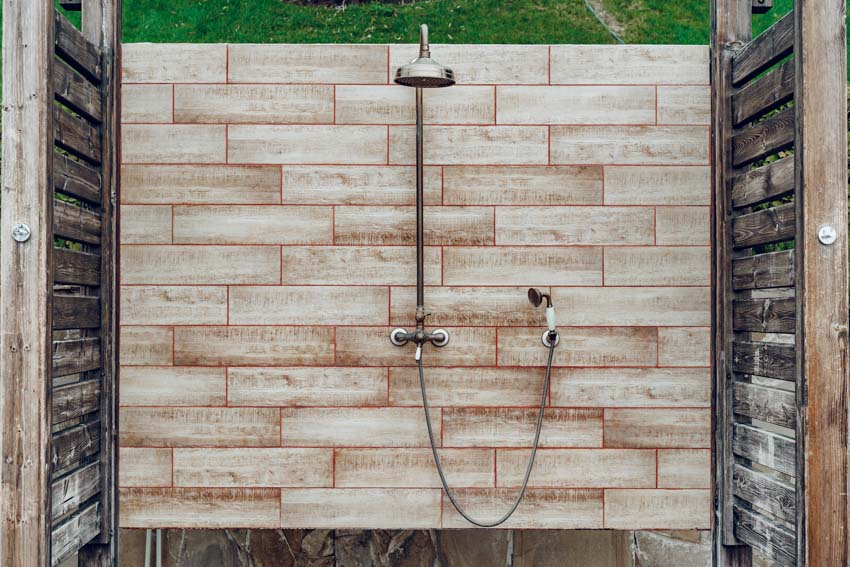
This DIY outdoor shower showcases a rain shower head on the wall, with a wooden enclosure. Wooden planks are arranged like bricks with the shower walls on the side made from dark-colored wooden planks. The wooden enclosure offers a rustic appeal to your home.
Kits for Outside Showers
A convenient and easy way to DIY an outdoor shower is by using a kit. Rather than building from scratch, an outdoor shower kit is an easy solution you can check out. They will include all the hardware needed to build one, such as a decking floor, shower walls, and a door.
Most of these kits are made from low-maintenance PVC, which can look stylish and elegant without costing you too much. If PVC is not your thing, you can go for a more organic style and then check out wooden designs. And the best thing is that you can complete your project build in just a day.
Pool Shower
Installing an outdoor shower near a pool is logical since you would need to wash before and after you use the pool. So if you have a pool at home, make sure you also have an outdoor shower near it.

This minimalist outdoor shower is installed near this swimming pool and with a wonderful sea view you can enjoy at the same time.
The gray concrete wall and floor tiles match the sky blue color of the sea and the tiles on the swimming pool. Very open and spacious, this design has two types of shower-heads, a rain-shower and a handheld wand.

This luxury swimming pool features an outdoor shower that has two shower-heads. This means more than one person can use it at the same time. While it uses the same floor and roof as the lounging area on the left, the bathing area uses a different color of walls with the pillar separating these areas.
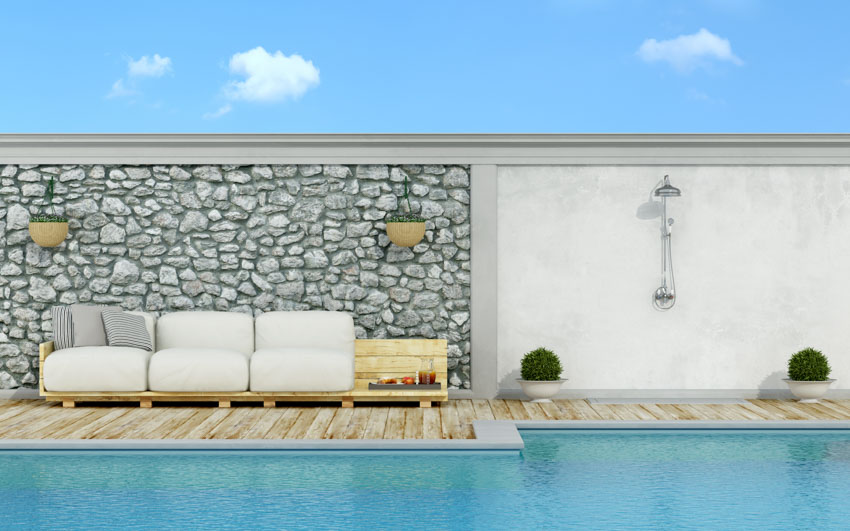
The outdoor shower and lounging areas both use the same light wooden planks for their flooring but have different walls and potted plants to set them apart from each other.
While the lounging area uses stone walls, the outdoor showering area uses concrete walls. The potted plants in both areas offer additional character to them.
Outdoor Solar Shower
An outdoor solar shower uses a more cost-effective mechanism to get the water running, compared to the expensive and complicated hot water lines, especially the ones from the pool area.
While limited in water capacity, this solar-powered system can provide enough water for several people. The water can also be heated directly by the sun, making it cheaper compared to a traditional indoor shower on top of an affordable installation.
Portable Showers
A portable outdoor shower is ideal for your grooming and showering during camping and other outdoor activities you might be involved in. You won’t have to worry about cleaning up after a sweaty and hot day in the middle of nowhere. It will also work perfectly well for bathing kids and dogs and washing dirty dishes.
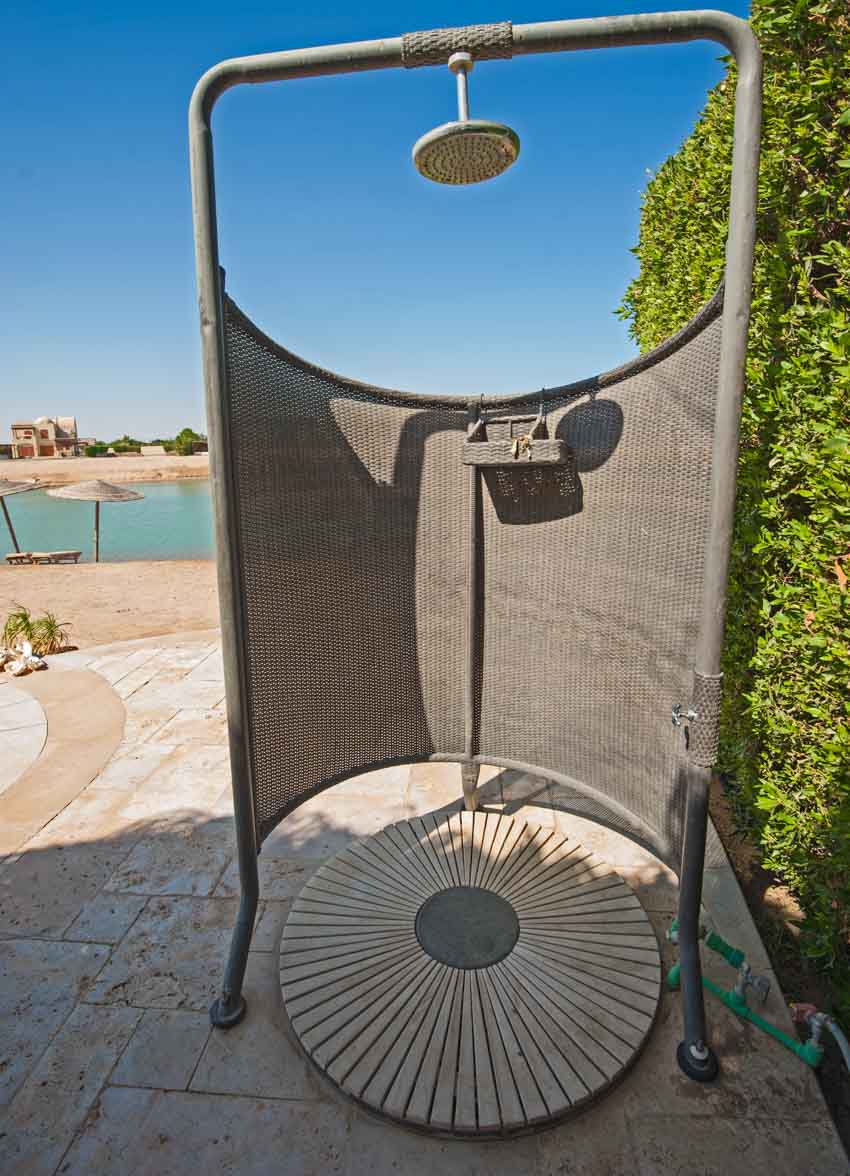
This outdoor shower features a portable cubicle with a rainfall showerhead at the top of it. The cubicle is made of metal, making it much more portable than wood. And the round platform can also easily be set up and packed up when you need to bring it somewhere.
Freestanding Showers for the Outdoors
A freestanding outdoor shower is one of the most common types found today. Compared to a wall-mounted outdoor shower, a freestanding one means that it is not directly connected to the home’s structure. It is in a separate area and can either be a portable or a stationary fixture.
Portable freestanding units are more affordable and cost almost nothing to install, while stationary ones are more expensive due to the installation of water lines and pipes.
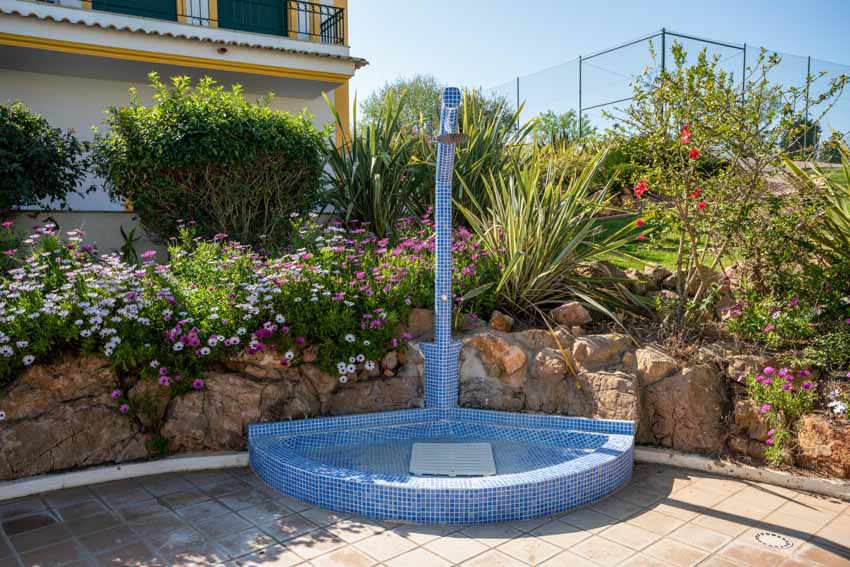
This freestanding outdoor shower features a traditional ceramic mosaic design using a rain shower-head at the top with a shallow platform where you can step in and stand.
The water is gathered in the platform while showering and then flows towards the drain outside. The color blue stands out among the beige tiles and the nature around the area.
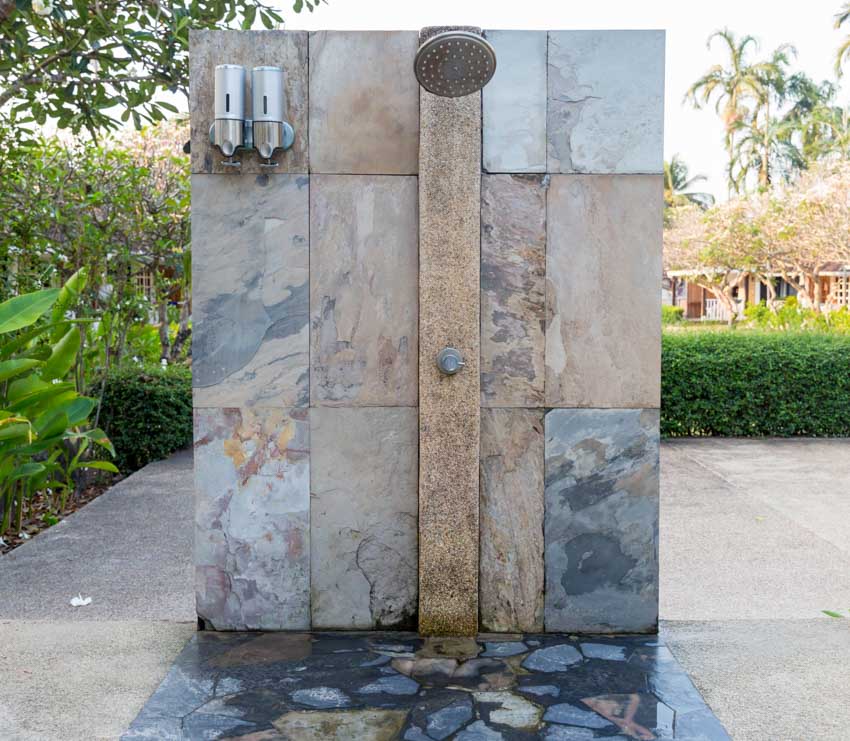
This freestanding outdoor shower features a large slab of stone to which the structure is connected, along with the controller and a shampoo and body wash dispenser on the left top part of the wall.
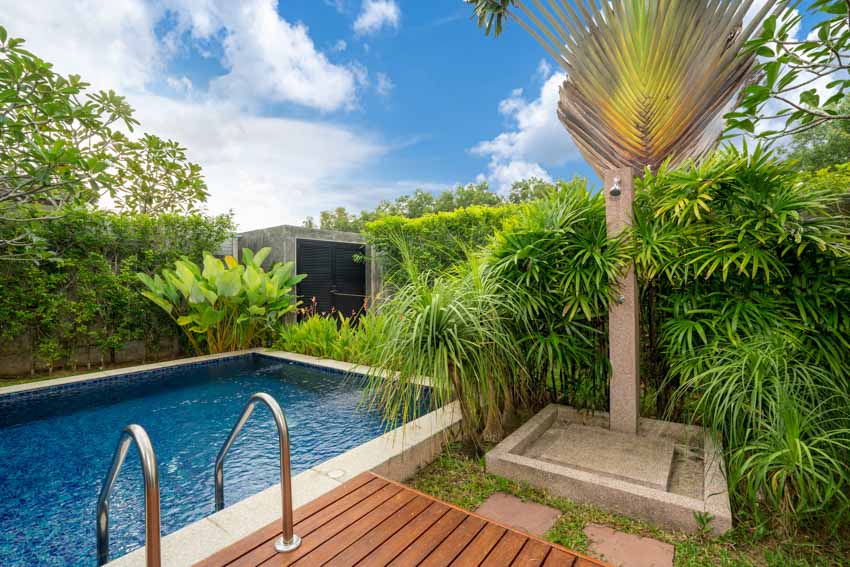
This freestanding outdoor shower is installed near the pool for convenience. The faucet and controller are attached to a long plank of concrete with a square platform.
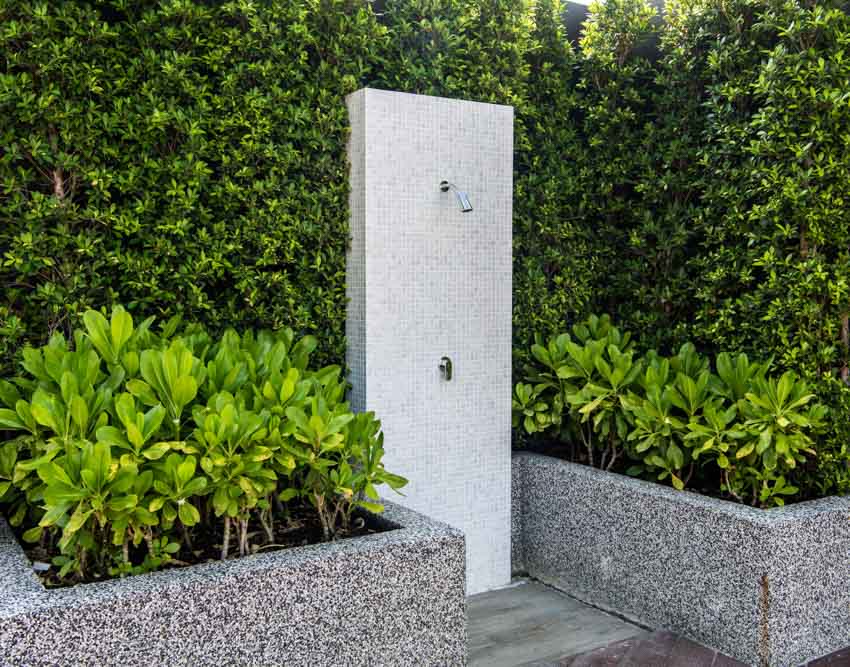
Inserted between two concrete plant boxes, this freestanding unit is simple inside, with the head shower and controller connected to a slab of stone. The greenery adds freshness to the area amidst the solid concrete and stone.
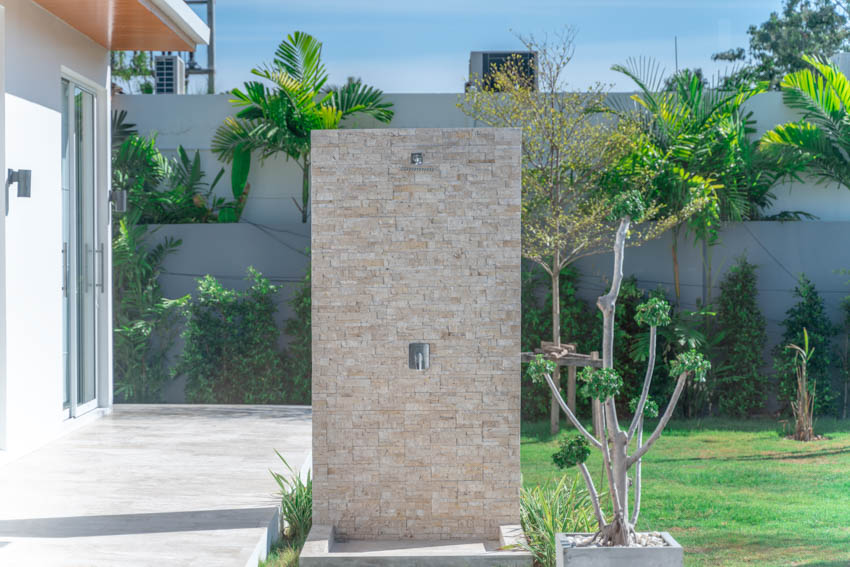
A beige stone lab houses the showerhead and controller of this freestanding outdoor shower. Styled in small bricks, the outdoor bathing space has a minimalist style. The plant beside it adds a natural vibe to the outdoor bathing space, which is perfect since it’s located in the garden.
Stone Showers
Stone is an excellent material for outdoor showers primarily because it remains cool when underfoot in hot weather. When you bathe, the water will remain soothing and comfortable.
The material is water-resistant and can withstand its constant exposure to water. It is also mildew and mold-resistant, which means that slipping is not a problem.
An outdoor stone bathing space is low-maintenance and won’t require much checking and cleaning. Its aesthetics also looks more authentic and natural compared to concrete. You can consider natural stones like river rock or bluestone as great options.
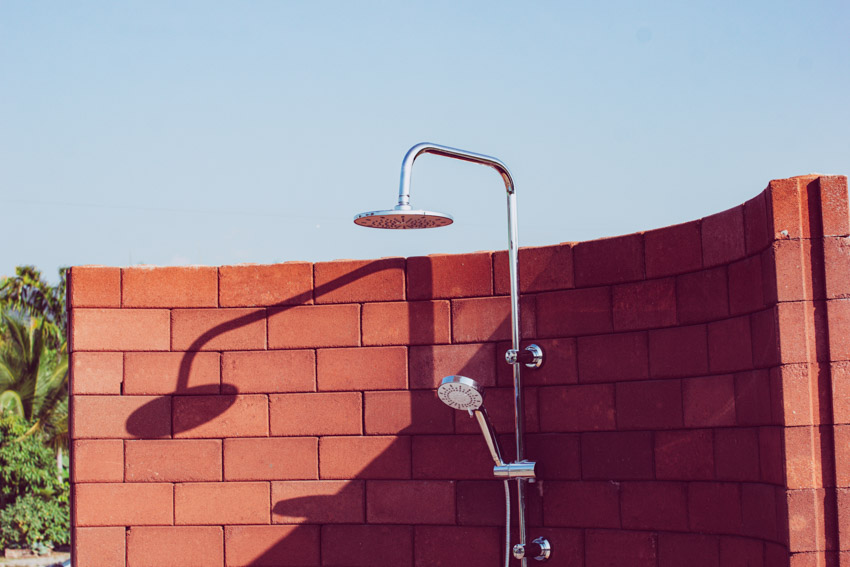
This outdoor stone bathing space features a red-brown brick wall where two types of spray-heads are connected – a vintage rain shower head at the top and a handheld connected to the pipe.
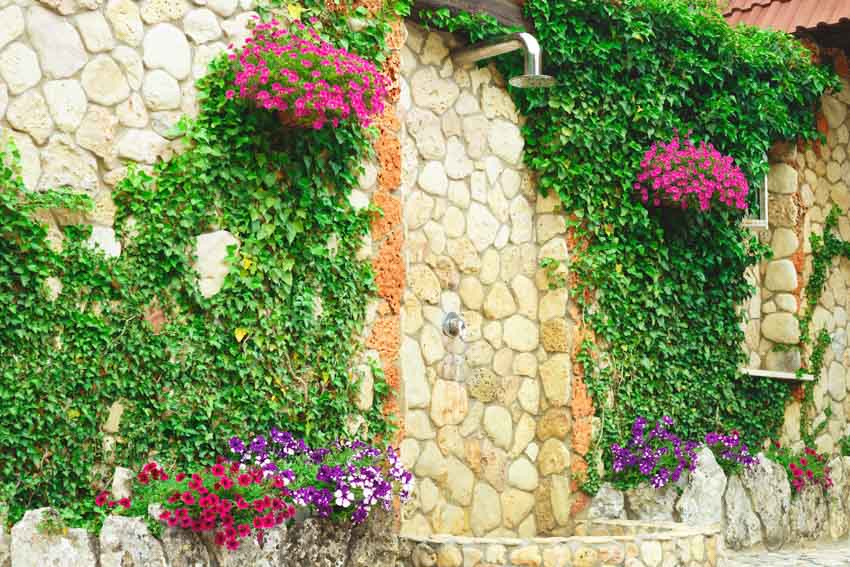
This stone outdoor shower is a wall-mounted one, where the bathing area is connected to the wall of the building. Large rocks were used to build the wall, and its platform. It’s bordered by greenery and flowers so you can easily recognize where the area starts.
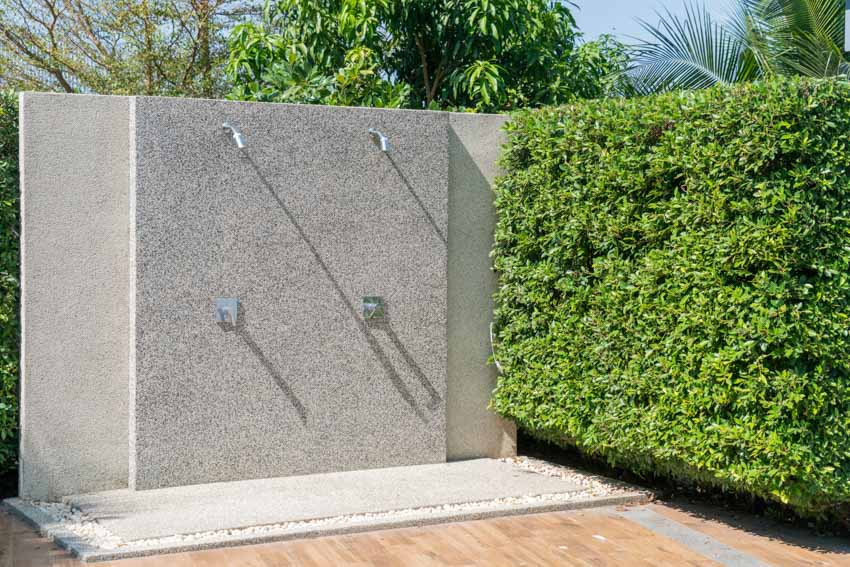
This stone outdoor shower can accommodate two people at the same time. Simplistic in its design, it has a concrete platform with small pebbles bordering it. Greenery adds a bit of vibrancy on the right side of the layout.
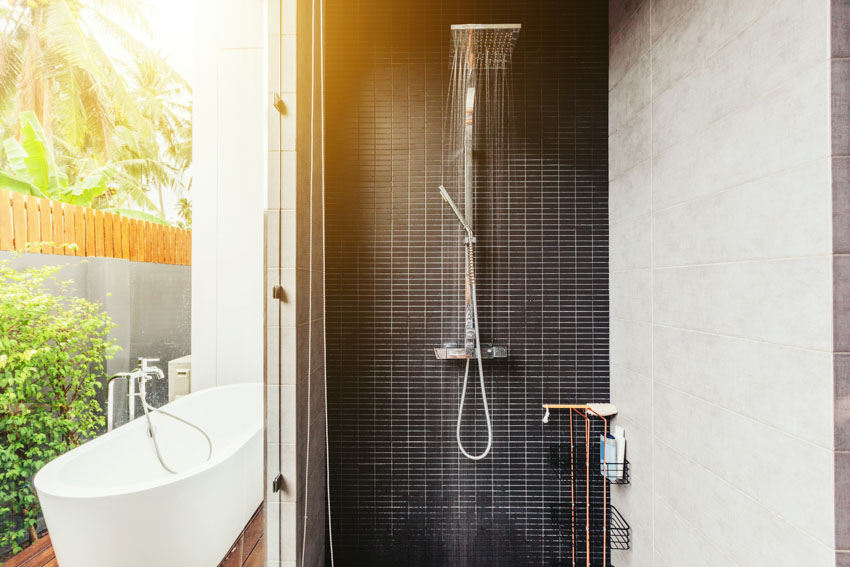
This luxury stone outdoor bathing space is found on the side of the home, along with a white marble bathtub. The rainfall showerhead and handheld spray are wall-mounted on black stone tiles, standing out amidst the neutral-colored walls, white tub, and wooden flooring. A glass sliding door may be used for more privacy if needed.

This stone outdoor wash nook is discreetly settled beside the house and mounted on the property’s wall. It seems to be integrated into the garden, with a neutral-colored stone tile where the rain showerhead is installed.
The wall also has pockets where pots of plants are settled in. The bathing space is also hidden by big plants and shrubs that you won’t notice if you don’t look for it.
Wood Showers
Wood is another material you can choose for your outdoor wash nook. Flexible in aesthetics, you have the option of either going for hardwood or softwood, depending on your budget and preference.
Hardwood is more durable than softwood but can be expensive, especially since it comes from slow-growing trees and can last longer. Some examples of hardwood are Oak, Cherry, and Teak.
Softwood, on the other hand, is more affordable, but it may not last longer than hardwood. In fact, you might actually pay more for softwood in the long run through its annual maintenance in an effort to make it last longer and protect it against weather elements. Some examples of this are Pine, Cedar, and Spruce.
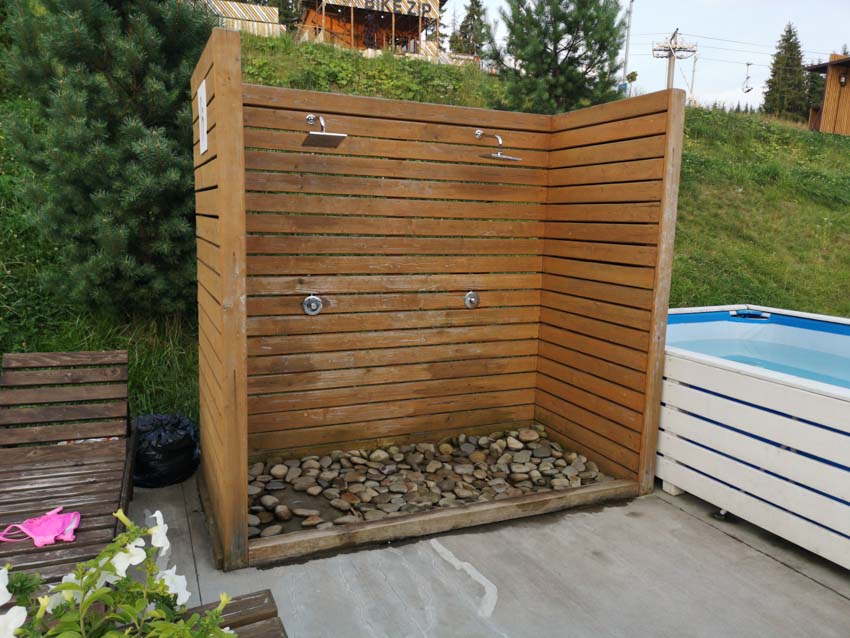
The theme of this outdoor wash nook is nature, with a wooden enclosure and platform made of stones. This outdoor bath space is made from brown wood, with the enclosure made from wooden planks arranged horizontally.
The wooden outdoor bathing space is integrated with two rainfall showerheads on top, which can accommodate two persons to shower at the same time.
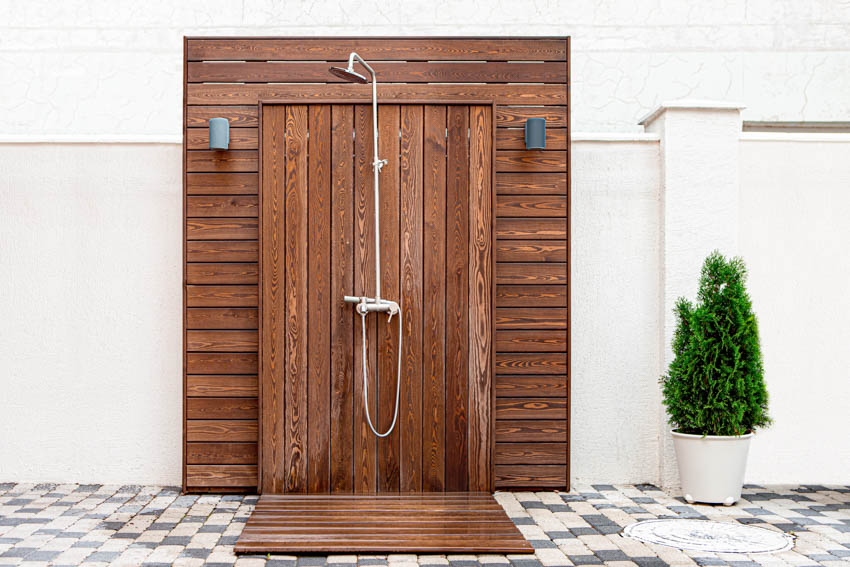
This trendy alfresco bath zone has brown wooden panels, walls, and flooring, and two spray heads are mounted, including a rain showerhead and handheld spray.
The wooden panels are arranged both horizontally and vertically and they stand out as they are surrounded by white walls and checkered flooring.
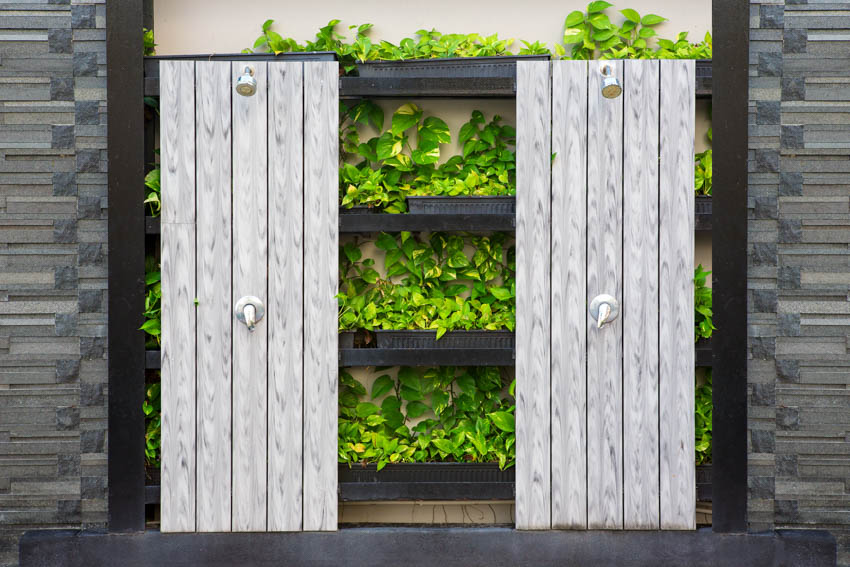
This modern yet rustic wooden bath zone features two areas with matching showerheads and control. The sprayers and control are mounted in white vertical wooden planks. The greenery at the back of the wooden wall offers a fresh look in the open-air spray head, giving the area more character.
Cedar Showers
Cedar is a kind of softwood that you can use as an enclosure for your showering zone. While it may not be as durable as hardwood, cedar performs well amidst moisture and can even resist mildew and mold.
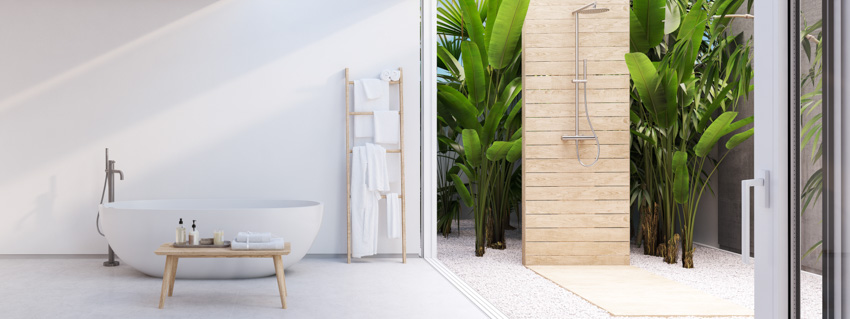
This cedar shower features a rainfall showerhead, horizontal wood panels, and flooring. The beige wooden panels look wonderful surrounded by white pebbles, walls, towels, a bathtub, and greenery in the background.
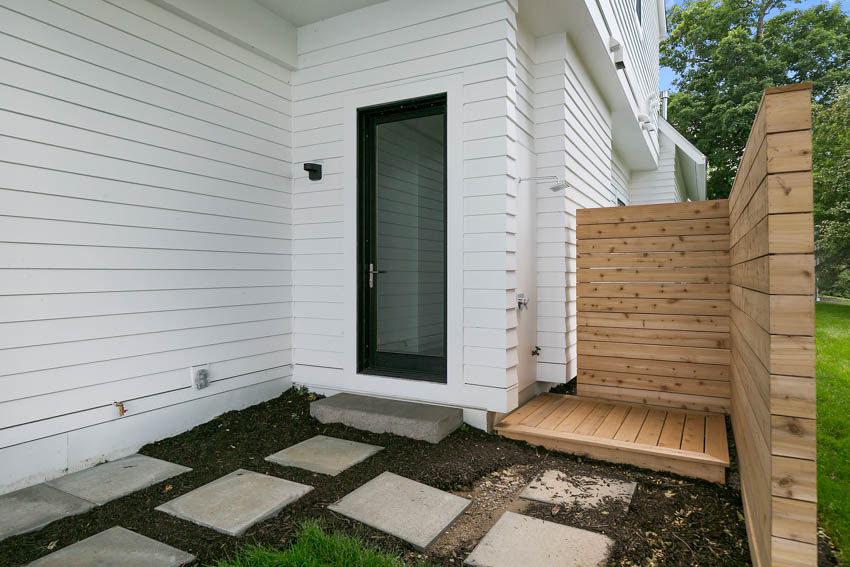
While the rain showerhead is mounted on the white wall of the home, the bathing space has a cedar wood enclosure that offers a bit of privacy to its user. The platform that acts as flooring is also made from cedar wood, matching the enclosure.
Concrete Showers
A concrete block open-air bathing space is more affordable than wooden and stone showers. Concrete blocks are flexible to use, so you can create whichever design you want. It may be less elegant to look at compared to other outdoor showers.
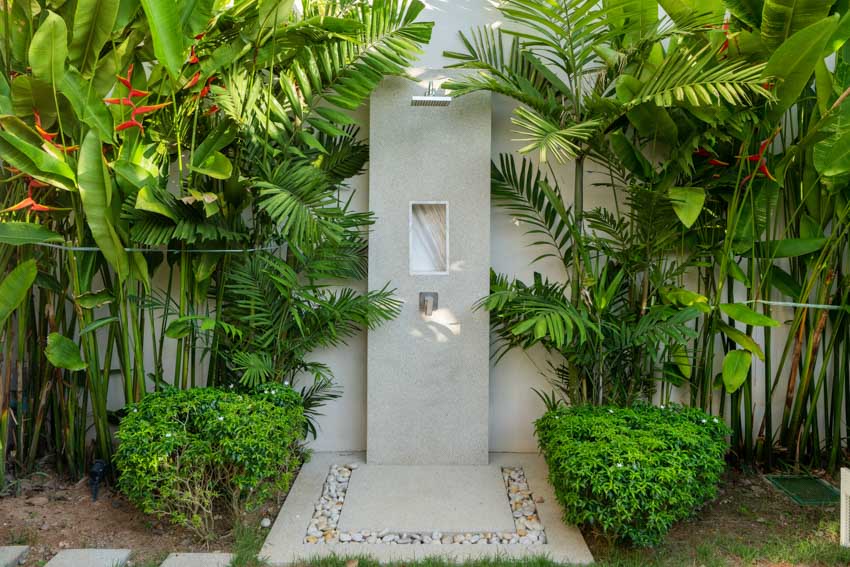
This concrete bathing space is installed inside the garden with concrete and pebbles as the platform and a rain spray head mounted at the top of the design. The outdoor bathing space is nestled in between lines of plants and shrubs.
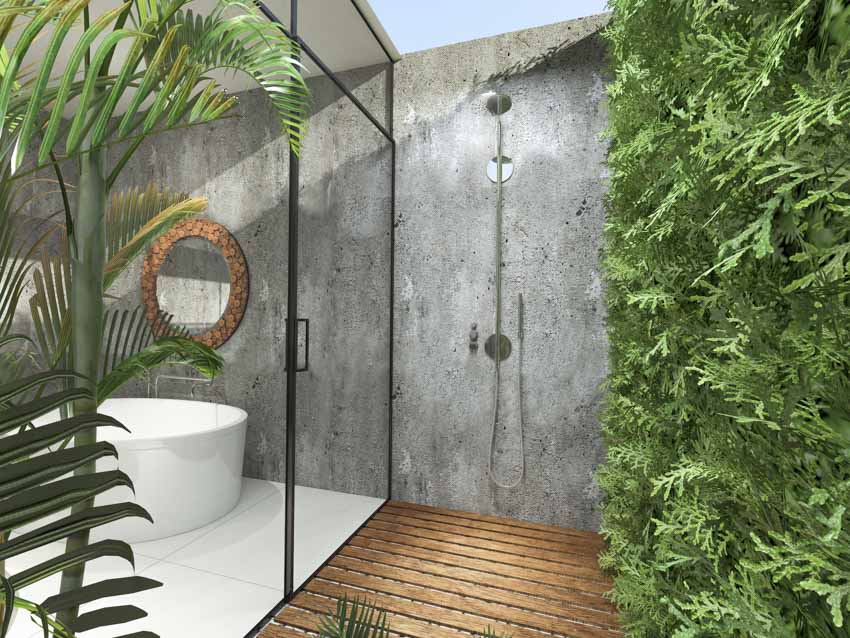
This cement bathing area has a tropical theme, with wooden planks as flooring and a concrete wall where the rain spray head is mounted. The concrete wall extends to the entire bathroom, and the wash area uses a glass door serving as its partition.
Rustic Style Showers
If you’re looking for something familiar and comfortable, even with less privacy, a rustic open-air bathing station may be the one for you.
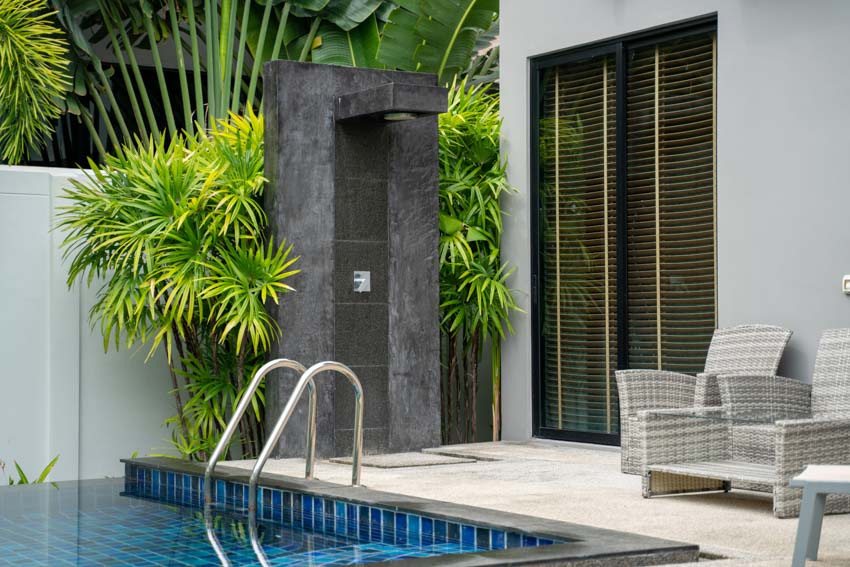
This rustic open-air bathing station features a black concrete wall into which the spray head is integrated. It is installed beside the pool for easier access. Adding greenery at the back of the wall provides the fresh look it needs to lift up its vibe somehow.
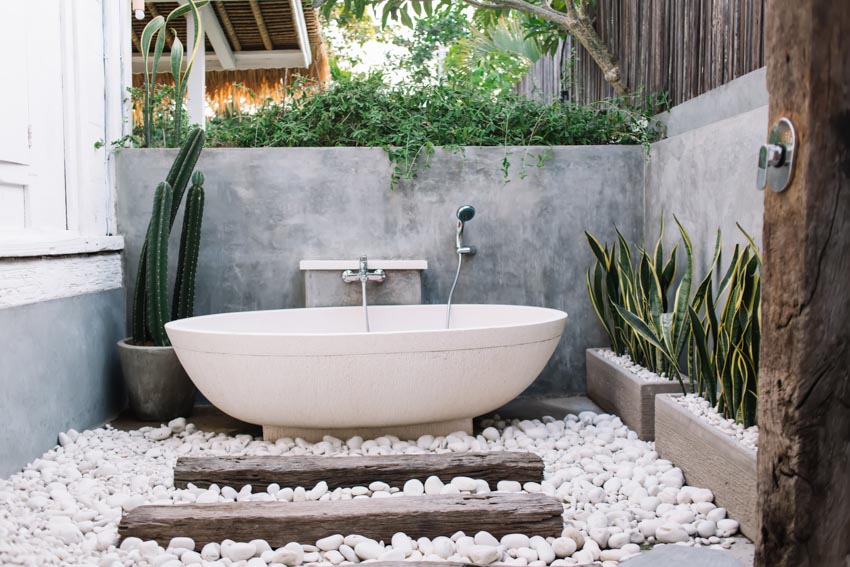
Set up surrounded by white pebbles nestled behind the house, this open-air bathing station includes a handheld spray head and a white oval bathtub.
The wooden large planks that serve as steps and the wooden plant boxes at the side reinforce a classic rustic vibe. The plants were used as accents in this rustic open-air bathing station.
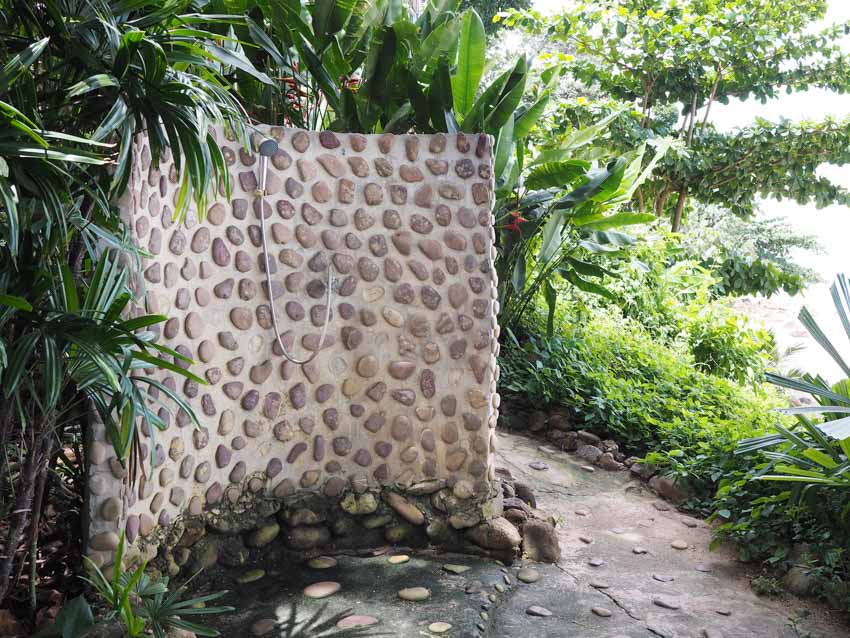
This stone open-air bathing station features a rustic vibe that you might feel in a tropical resort. This stone wall has a handheld spray head you can use. The design and spray used are simple in their essence.
Modern Designed Showers
If you are thinking about installing a modern open-air bathing station, you can either go for something unique or a trendy style.
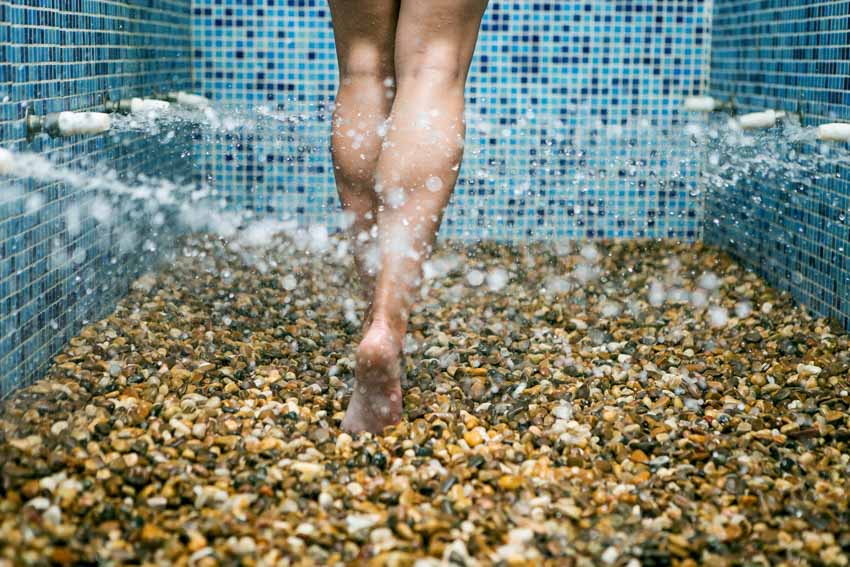
This modern bathing station features horizontal shower shots. While you won’t be able to bathe here, you can clean your feet with it. The pebbled flooring looks magnificent when paired with the blue tiles.
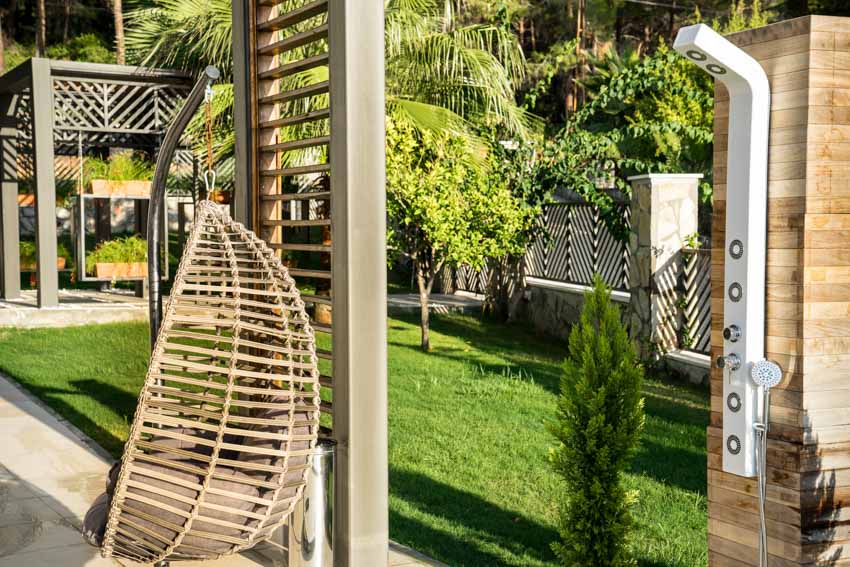
This modern open-air bathing station uses a trendy bathing space with an overhead spray and a handheld one. Its white color offers a clean look that stands out on the wooden pillar it’s mounted to.
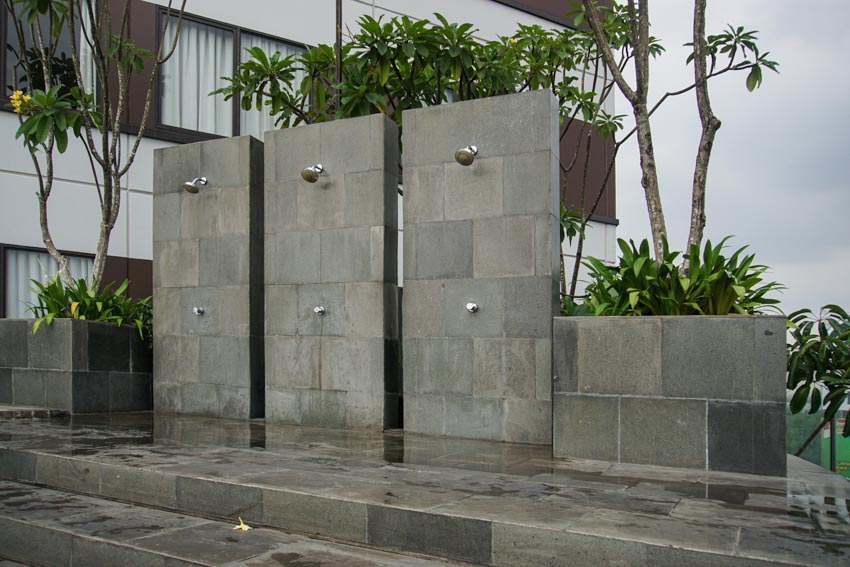
This modern open-air bathing station features three sets of pool showers, accommodating three persons simultaneously. These three open-air showers feature dark-colored stone tile walls and sleek and clean flooring.
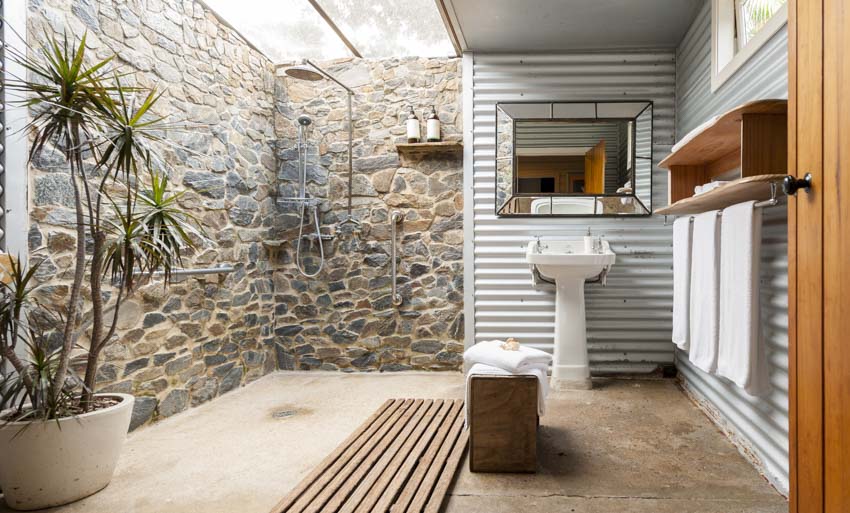
This modern setup is a mix of an indoor bathroom and an open-air bathing station. The bathing space features two shower heads – one rain shower head and one handheld shower.
The stone walls look creative, and the concrete flooring matches the walls perfectly. The large potted plant acts as an accent in the area.
Beach House Showers
One of the best places to install an open-air bathing station is the beach house, where you must wash up before and after swimming on the beach.
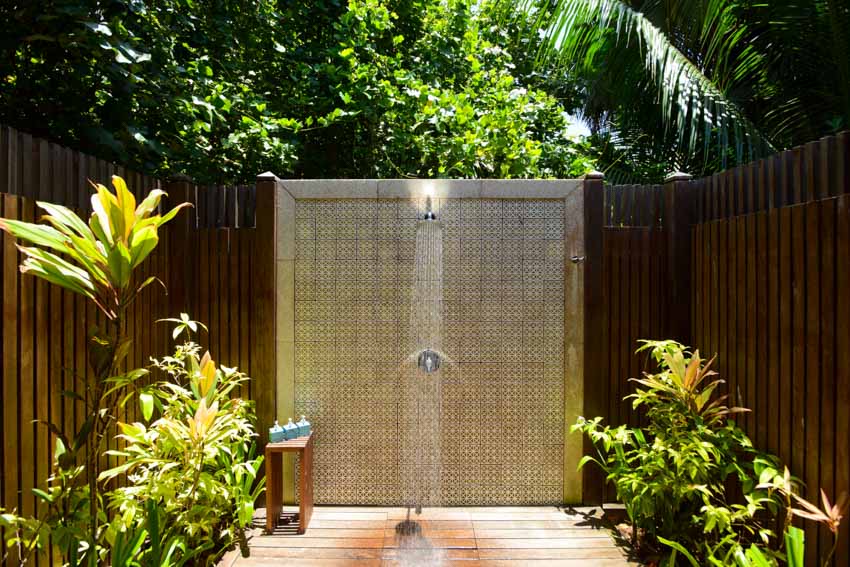
This beach house open-air bathing station features an overhead rain spray that flows through the wooden planks flooring. The plants add charm to the area and the wooden walls contribute to the “nature” feel of the bathing area.
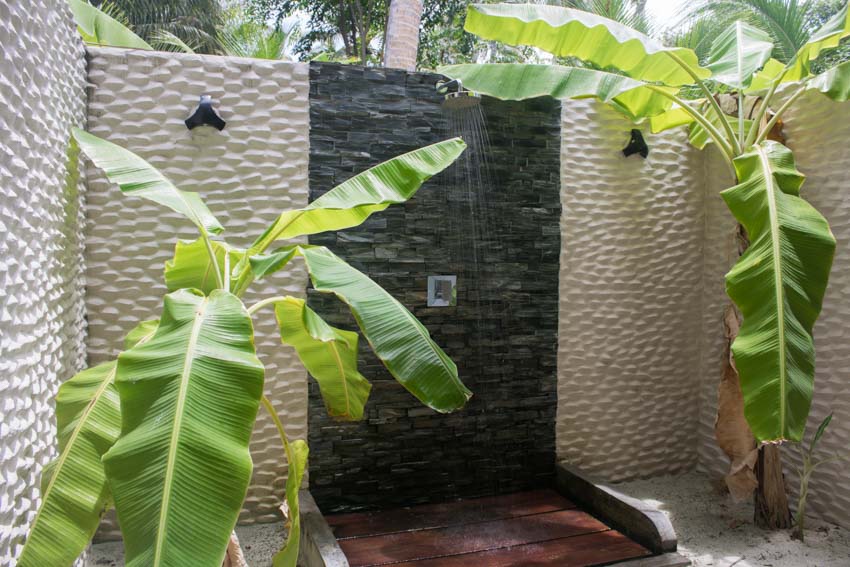
With its tropical vibe, this beach house open-air bathing station has wooden flooring and creative stone walls. The bathing space area is evident in the black wall area. It also has several banana trees growing inside, adding a relaxing appeal to the area.
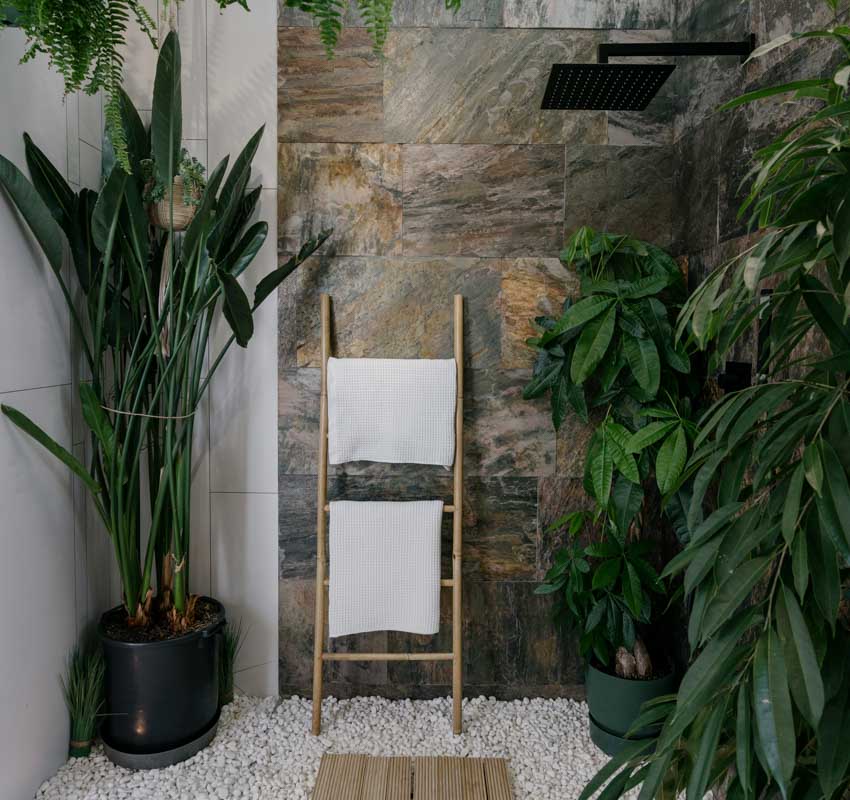
This beach house’s open-air bathing station features a black rain spray head mounted on the stone tile walls. The entire look is tropical, with a wooden hanger with clean towels, a white pebbled floor, and a variety of green plants.
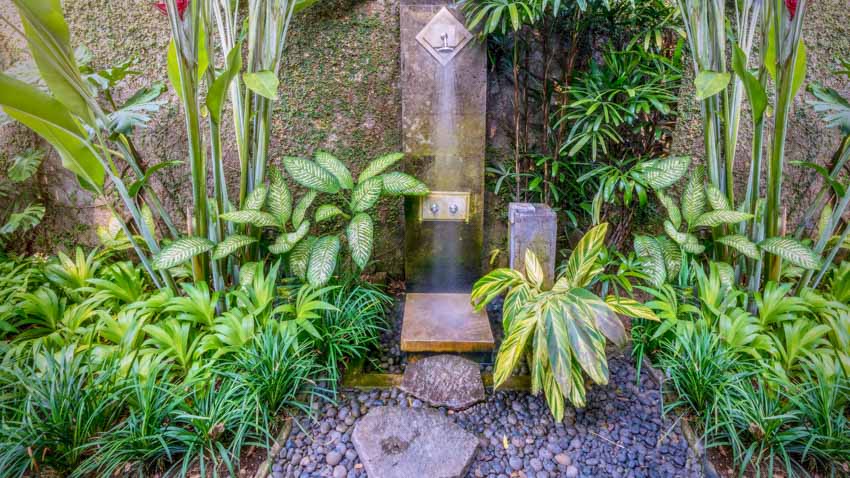
Limited in space, this beach house showering space is nestled in the middle of a tropical garden. Its platform is made from natural stone and pebbles, giving a luxurious vibe to the area.
Stainless Steel Open-Air Showers
Stainless steel is another flexible and customizable material that can be used for your open-air bathing station. When exposed to the sun, the metal may turn hot, including the water.
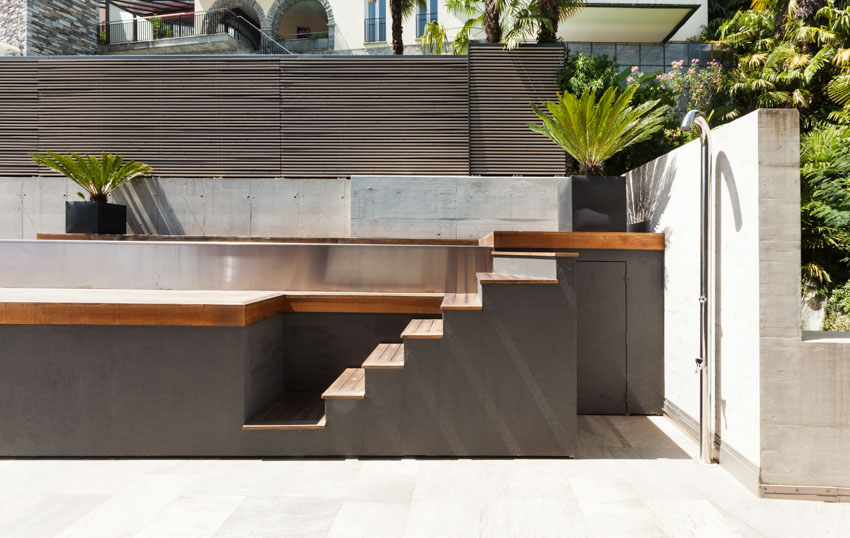
This stainless steel open-air bathing station is minimalistic, with the pipe installed and connected from the underground. This is a no-nonsense bathing corner that you can use before and after going into the pool for a swim.
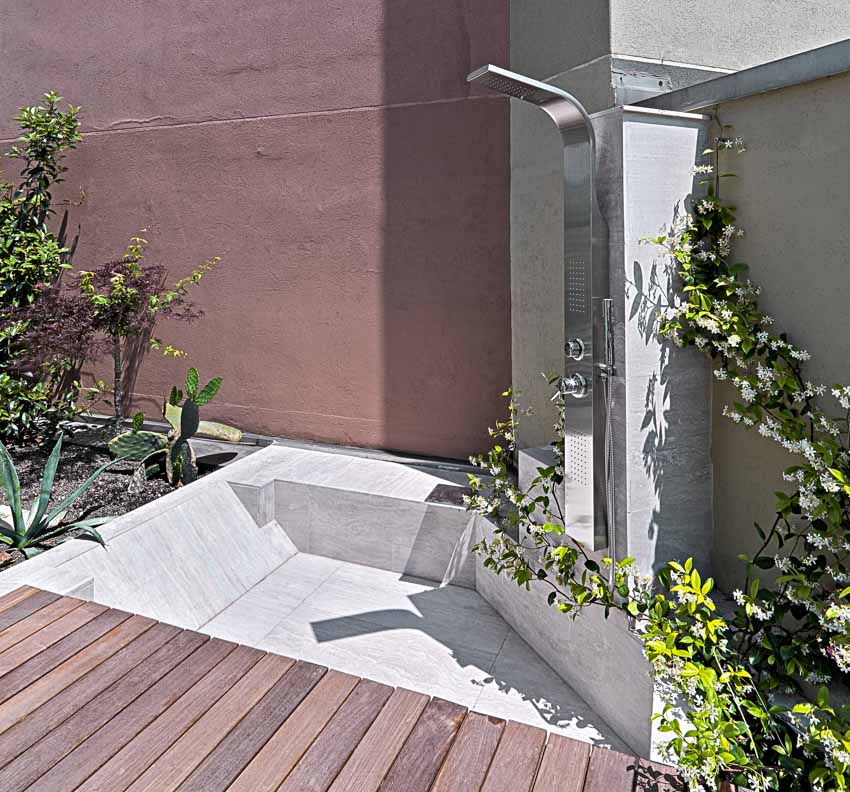
This modern-styled bathing corner uses a stainless steel cascading head. The spray set is mounted on the stone wall and surrounded by nature in the form of wooden flooring and greenery.
Open-Air Platforms for Showers
An outside showering platform is an element in the bathing corner that you would have to step on to enjoy the cold water from the spray head.
The platform should be durable, practical, and aesthetically pleasing at the same time. Of course, it should also match the design of the entire bathing corner.
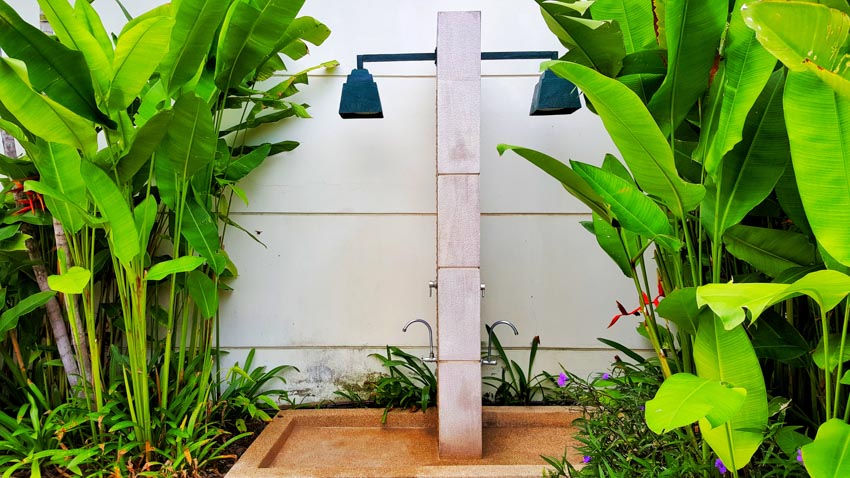
This rustic rinsing space features a concrete platform on both sides of the elongated concrete bar, where two head cascading water streams are installed in.
Shower Floor Ideas
When it comes to an outdoor shower floor, you can choose from various materials. Whatever you choose, make sure it matches the bathing corner and the entire bathing area’s style and running vibe.
Concrete Flooring
Concrete floor is a good consideration and one of the most popular. This usually comes in the form of a dug-out square/rectangle platform.
The gravel is usually on the bottom of the platform, and it is bordered by a different material. A concrete rinse space floor normally has a non-skid surface that makes sure you won’t slip while showering.
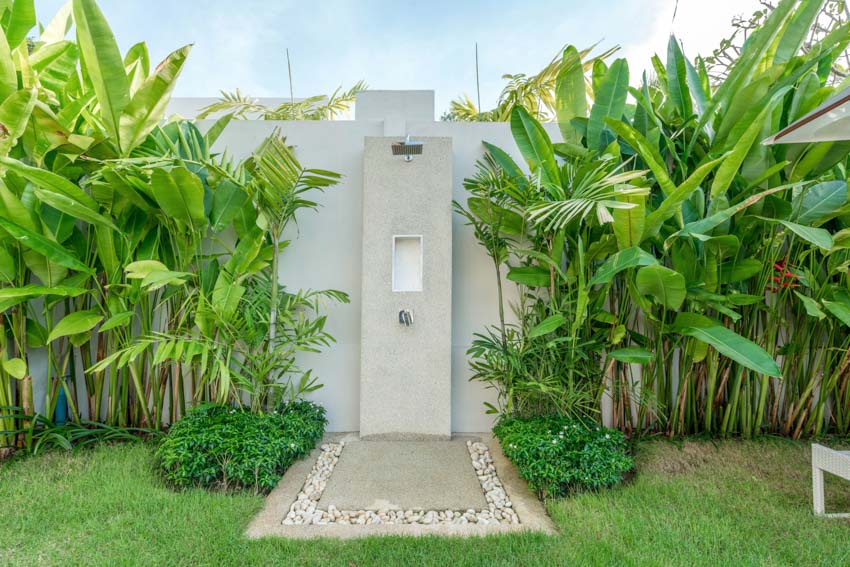
The concrete floor in this design features the same material that the concrete used on the wall where the bathing corner is mounted. The platform used white pebbles as its border.
Wood Flooring for Showers
Wood is another excellent material you can use as a corner floor for bathing, whether you choose weather-resistant wood as a deck-type flooring. Make sure to leave a space below the deck to support air circulation for mildew prevention and air drying. You can add a frame over the deck.
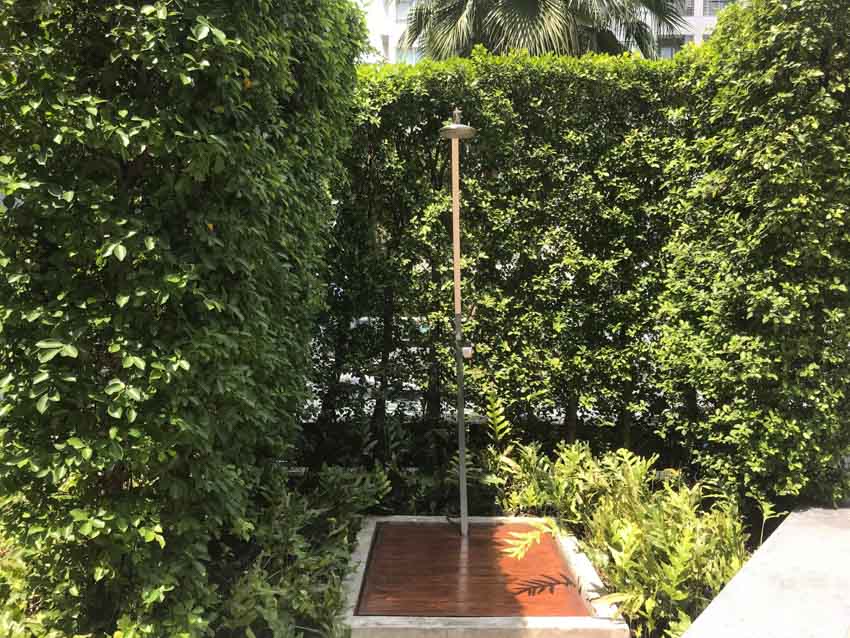
This fresco rinse space features a wooden platform with a stone/concrete border as its frame. The wooden flooring matches the “nature” vibe in the bathing area reinforced by the large bushes and greenery as its enclosure.
Stone Flooring
Stone is another durable material you can choose for your open-air bathing corner floor. Weather-resistant, it is guaranteed to be capable of enduring constant exposure to water without making your feet slippery since it’s textured. Limestone and bluestone are popular choices for the shower’s floor.

This stone exterior bathing space floor has the same material as the pillar where the spray head is mounted and installed in. The tiles will feel comfortable when in contact with your bare feet without the risk of slipping.
Shower Flooring with Drains
Besides having a natural kind of drain (like the soil), you can also choose to install a drain open-air bathing corner floor. It would require more budget and effort though since you would need to install one in the area.
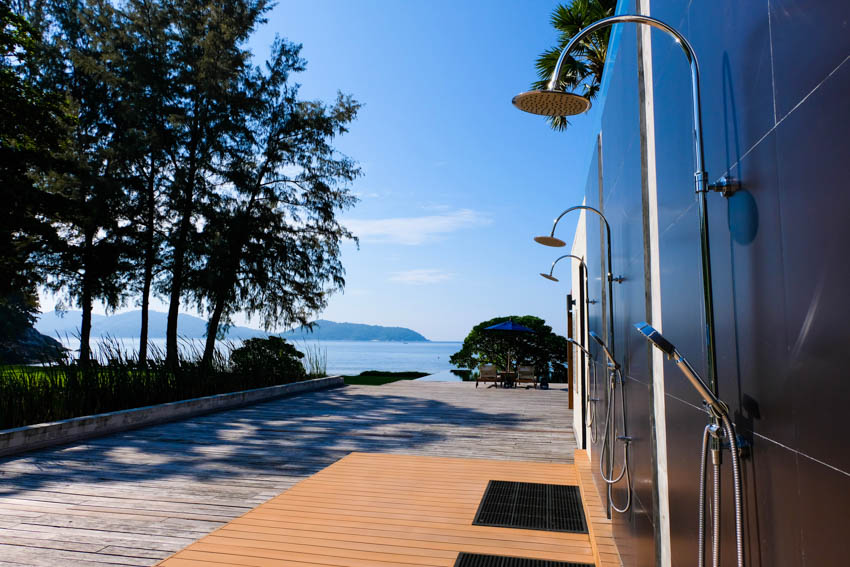
This rinse space area features three sets of showers that all have a rain cascading head and handheld spray head. The drain is just right beneath the bathing corner and is framed by wooden planks.
Showers with Water Heater
You can install open-air water heaters if you somehow prefer warm water, even on hot days. Most outside showers do not have a water heater, though since you won’t be able to bathe outdoors if it’s too cold in the first place. However, there is also a natural form of the heater through the sun.
How Much Does a Shower Outside the Home Cost
Outdoor showers cost around $500 to $8,000 with an average of $3,000 depending on the materials needed to build one, as well as the plumbing necessary for it to function.
Wall-mounted showers fall around $100 to $500, while freestanding ones are around $500 to $2,000. And finally, the most affordable type is the portable shower, costing $50 to $300.
Professional installation alone costs $100 per hour. If you prefer a bathing corner kit though, it will definitely save you a lot of money since it only ranges from around $350 to $450.
Is A Shower Outside Worth It?
Yes, an open-air bathing corner is guaranteed to be worth it. If you’re thinking about the fun experience itself, it’s actually more than that. A showering space outdoors can actually increase the value of one’s home. While building one may be expensive, it’s going to be worth it once it doubles the value of your home.
Can Any Shower Fixture Be Used Outdoors?
No, you can only use bathing corner kits and parts that have been specifically designed for open-air usage. Make sure you check the bathing station fixture first to see if it’s compatible with outside use before purchasing it.
Do These Shower Types Need a Drain
Many open-air rinse kits use a natural drain with the water running off into the ground. With some of the city’s strict codes about drains, though, you might be required to install water disposal.
If you’re not too sure about the capacity of the ground where you plan to install your showering space, choose to install a drain to play safe. This will also avoid the possibility of the rinsing water running off inside your home.
See more related content in our article about an open concept shower on this page.

